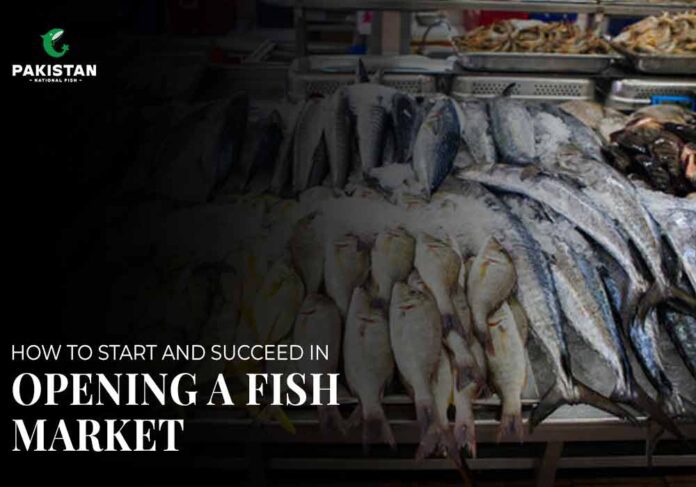Starting a fish industry can be profitable if the demand for fresh fish is high. It serves consumers, restaurants, and wholesale buyers. However, success requires proper market knowledge, fish procurement, marketing, and effective business management.
This is a clear guide on how to go about opening a fish market, and indeed how to do it profitably.
1. Conducting Market Research
- Identify Your Target Customers: Who will buy from you? Who are the target consumers: the end consumer or the individual customer, nearby seafood restaurants, or wholesale buyers? This knowledge will assist one in stocking the right products.
- Analyze Competitors: Go to the local fish markets and pay close attention to their prices, the type and quality of fish they offer, the type of persons serving their customers, and the general hygiene found at these places.
- Assess Location Needs: It is good to select a place that is close to the target market, and the best part is if the place has a lot of people traffic. Make sure it is in a region where there is demand for seafood for both the counters and the markets.
2. Developing A Business Plan
- Executive Summary: Explain your overall business concept, the function of the business, and the most significant features of the fish market.
- Market Analysis: Ensure that you integrate your research findings with your ideal audience and competitors.
- Product Line: Explain the variety of seafood that you will be serving (main and exotic seafood, fish and shellfish) and where you’ll source them from.
- Financial Plan: Forecast your start-up expense, revenue, pricing, and profit. One of the common tools that should not be missing is a break-even analysis to know when you will start making your profits.
- Marketing and Sales Strategy: Explain how you will capture and sustain consumers and customers including through advertisement and consumer offers.
3. Securing Licenses and Permits
- Business License: There is a need to register your business while applying for a license from the local authority.
- Food Handling Permits: For this reason, food safety standards need to be observed due to the perishable quality of seafood. Get the required licenses concerning the disposition of seafood.
- Environmental Permits: It becomes clear that waste disposal remains part and parcel of seafood retail. This is because in handling the wastewater or any byproducts you may require a permit to do that if you want to meet some environmental standards.
4. Sourcing Fresh, Quality Seafood
- Local Fishermen: Source fresh fish and seafood from the nearest fishermen so that you can get your fish from them at decent prices.
- Fish Farms: Fish farms are a reliable source for steady production, provided for species that are popular such as tilapia, catfish, and shrimp.
- Seafood Distributors: These are suppliers that are available in a broad range of fish types and can supply big quantities if asked to but at a certain quality they charge high.
5. Setting up The Market
- Display and Organization: A good display promotes your quality seafood. Arrange your market manner so that users may directly look at and choose their ideal types of fish and seafood.
- Storage and Refrigeration: Fish tend to go bad very fast, the best thing is to ensure you acquire the best quality refrigerator and freezing items. Temperature regulation is maybe the most important factor in order to preserve seafood and make it fit for consumption.
- Cutting and Cleaning Stations: Clients may ask for particular steaks or washing of fish. To benefit from your service, you should ensure that you have clean and professional quality cutting stations.
- Hygiene and Cleanliness: Fish markets especially have that specific smell that you must ensure that your place is clean so that customers will not be turned off. It is effective in washing the surfaces, cutting boards, and flooring as well as in providing adequate ventilation all through.
6. Marketing Your Fish Market
- Social Media and Online Presence: The number of posts inspires new arrivals, special offers, and general information about cooking and seafood quality on social networks. They also help to create more awareness and develop more accessibility so that your customers can easily find you.
- Loyalty Programs: Give first-time customers a little deal or freebie because they’re new or offer long-term deals for those who are loyal returning customers.
- Collaborations with Local Restaurants: It is necessary to establish business relationships with other restaurants and to diversify the buyer’s market thus raising awareness of your services among local cuisine consumers.
- Community Engagement: Developing events such as seafood samplers, cooking demonstrations, or daily specials that introduce new fish to the consumer will help to pull new customers into the fish market and ensure customers have a sense of belonging to the fish market.
7. Managing Operations and Inventory
- Daily Inventory Checks: Selection should be always up to date, so make certain to restock your inventory daily in order not to overstock some items or have them gone bad.
- Quality Control: Strengthen screening mechanisms in a bid to be certain that products to be sold are from the most recent batch.
- Record-Keeping and Analytics: Regularly track sales data so that you can know how sales are likely to happen soon, then be able to plan the kind of inventory you would wish to have in the market.
8. Building Long-Term Success
Creating a good fish market is not a flashy event rather it requires some time and hard work in addition to customer consideration. Continue the learning process, listen to the customer, and know the developments taking place in the seafood market. Seasonally or from time to time, change your production menu immediately consider new types of fish, and create new marketing concepts.
Otherwise, free from complications arising from unsatisfactory quality and cleanliness standards, a firm customer base made up of repeat customers and referrals will be achieved. When these best practices are put in place through attention to quality, the fish market can be stable, provide a service to a community as well benefit a sustainable seafood industry.


